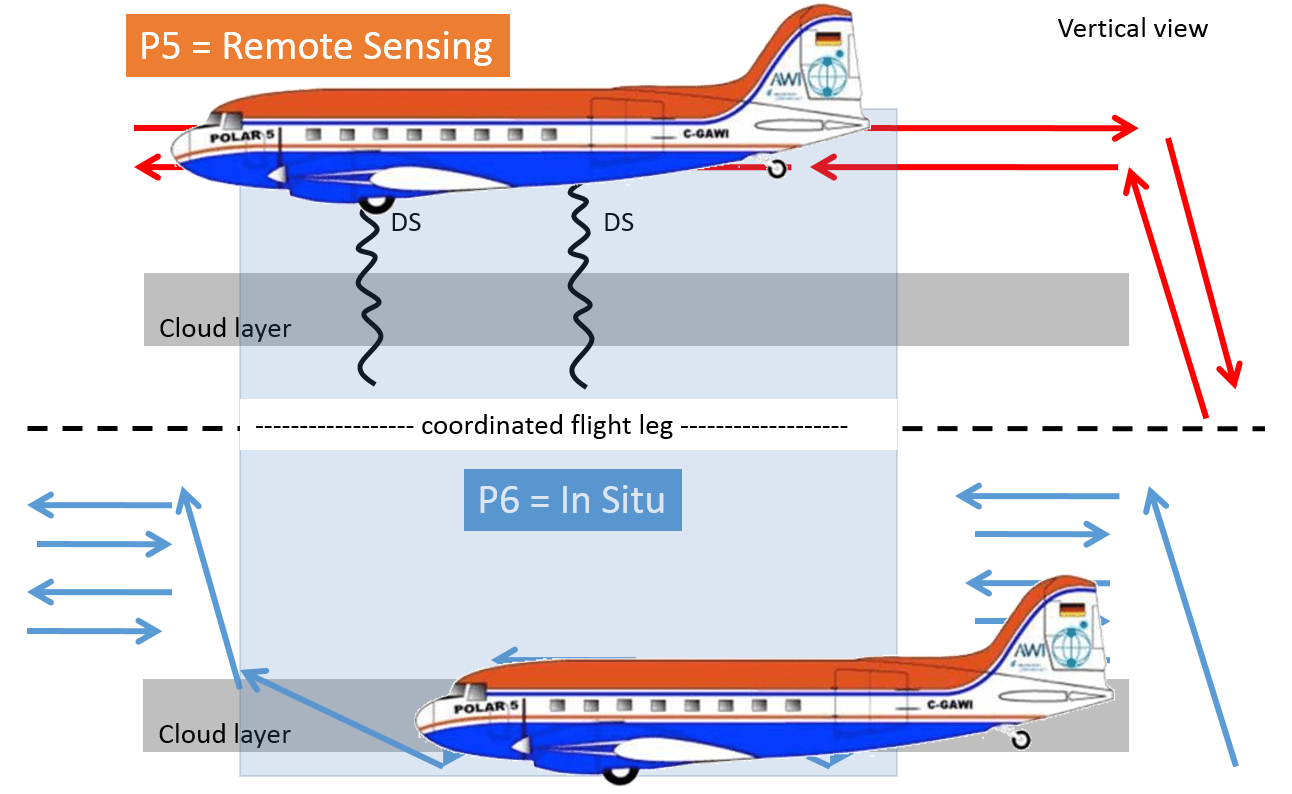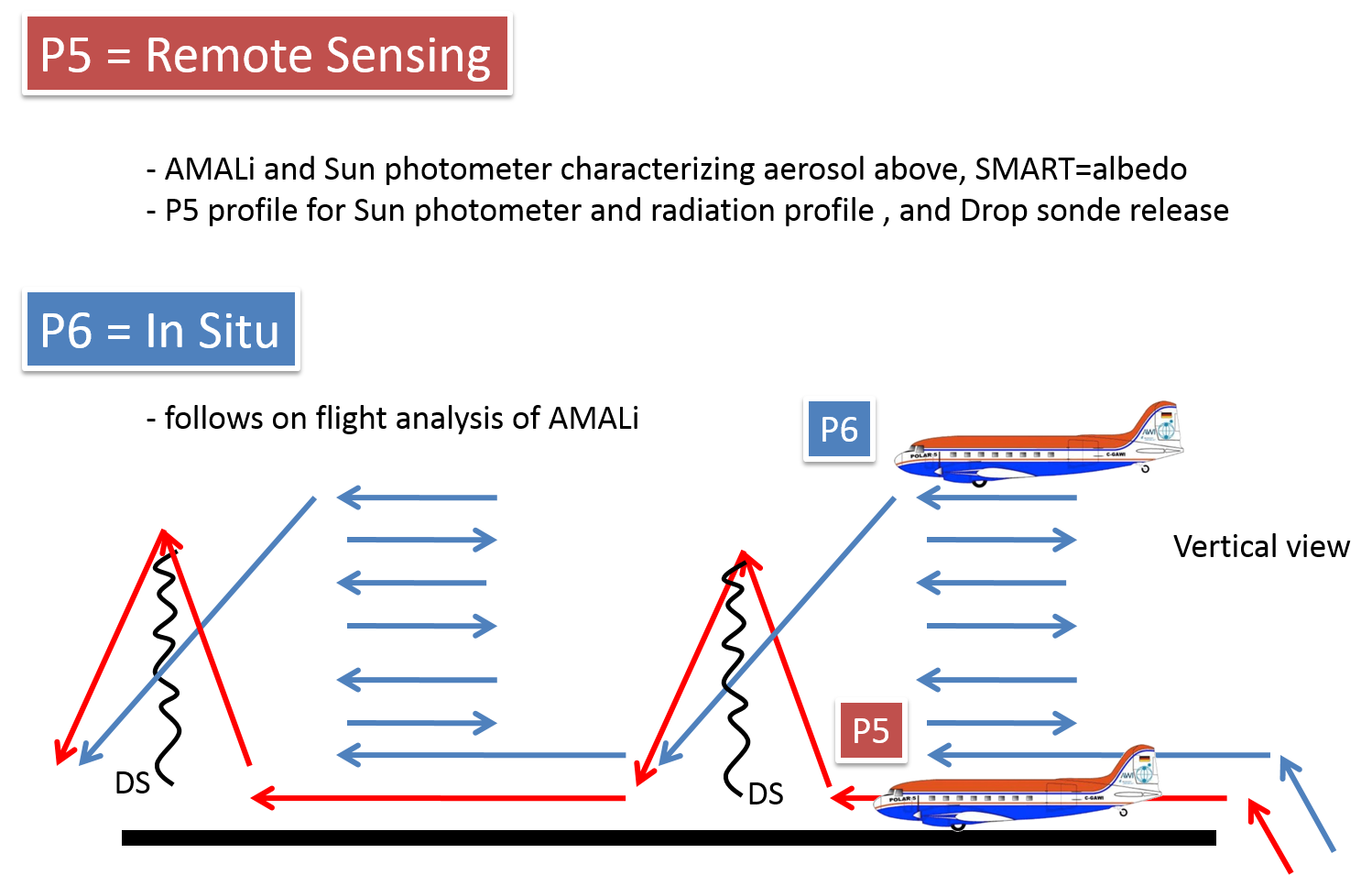
For RACEPAC altogether 60 flight hours for each of the two AWI aircraft (Polar-5 and Polar-6) are
allocated in AWI's operational schedule for spring 2014 in the Canadian Arctic. The Polar-5 will be
equipped with remote-sensing instrumentation, while the Polar-6 will
carry in situ probes for cloud, aerosol and trace gas characterization. The aim of the measurements
is to study cloud-aerosol-radiation interactions by compiling a set of collocated remote sensing and in situ data.
The data will be used for closure studies relating in situ cloud properties to measurements of cloud
top albedo/reflectivity, process studies of how aerosol properties
may changing cloud particle and quantifying the variability of Arctic clouds, aerosols and trace gases in general.
Instrumentation
Remote sensing measurements comprise active remote sensing by the backscatter and depolarization lidar AMALi, spectral solar radiance and
irradiance measurements by the SMART-Albedometer, an imaging spectrometer AisaEagle, an all-sky camera and an airborne sun photometer.
From these remote sensing instruments, cloud and aerosol quantities such as optical thickness, effective particle diameter, cloud thermodynamic
phase, cloud and surface albedo and BRDF can be derived.
In situ observations will quantify aerosol particle concentration, size and chemical composition. Cloud
condensation nuclei will be separately detected and trace gas measurements be used to estimate the
origin/sources of the aerosol particles. Cloud particles will be sampled by six different cloud spectrometer probes
including the Small Ice Detector (SID-3), the Novel Ice Experiment-Cloud
and Aerosol Particle Spectrometer (NIXE-CAPS), the Cloud Combination Probe (CCP), the
Precipitation Imaging Probe (PIP), the holographic HALOHOLO probe, a polar nephelometer and alternatively
the Particle Habit Imaging and Polar Scattering (PHIPS) probe. The probes are located under the aircraft wings and observe cloud
particles in open-path geometry with instrument tips being shaped to avoid shattering of cloud
particles. Together these instruments are able to detect particles in a range between 1 μm and 6
mm and characterize their size, number concentration and thermodynamic phase.
A list and specifications of all instruments can be found here: Instrumentation List
Flight Pattern
Measurements will be divided into cloud and clear sky missions with the majority of flights dedicated to clouds while
back ground conditions such as surface albedo and aerosol profiles, will be characterized during the clear sky missions.
Cloud Mission
The Polar-5 equipped with remote-sensing instrumentation will fly above the cloud, while the Polar-6
carrying in situ probes will fly inside the same cloud layer closely collocated with Polar-5. This
collocated positioning of the two aircraft can be maintained over extended flight periods, because
both aircraft are of the same type and fly at the same speed. Under these conditions, the data refer
to an identical parcel of the cloud layer, without temporal displacements which are unavoidable when
measuring from a single aircraft, during which the cloud properties are likely to change.
Horizontal cloud inhomogeneities can now be directly linked between the individual data what allows to
quantify individual microphysical and radiative processes more precisely. Additionally, the collocated
measurements allow to improve and validate cloud retrieval algorithms for remote sensing.

Clear Sky Mission In situ measurements of Polar-6 will focus on aerosol and trace gas profiles in the cloud free atmosphere. The remote sensing configuration of Polar-5 will be switched to zenith observations by AMALi. With AMALi able to detect aerosol layers online during the flight, Polar-5 will fly ahead and guide Polar-6 into the most interesting aerosol layers. Additionally, the surface energy budget will be quantified by measuring surface albedo and BRDF with Polar 5.
